What is ransomware? Everything you need to know about one of the biggest menaces on the web
What is ransomware?
Ransomware is one of the biggest cybersecurity problems on the internet and one of the biggest forms of cybercrime that organisations face today. Ransomware is a form of malicious software – malware – that encrypts files and documents on anything from a single PC all the way up to an entire network, including servers.
Victims are left with few choices; they can either regain access to their encrypted network by paying a ransom to the criminals behind the ransomware attack, restore data the from their backups, or hope that there is a decryption key freely available. Or they start again from scratch.
Some ransomware infections start with someone inside an organisation clicking on what looks like an innocent attachment that, when opened, downloads the malicious payload and encrypts the network.
Other, much larger ransomware campaigns use software exploits and flaws, cracked passwords and other vulnerabilities to gain access to organisations using weak points such as internet-facing servers or remote-desktop logins to gain access. The attackers will secretly hunt through the network until they control as much as possible – before encrypting all they can.
SEE: Cybersecurity: Let's get tactical (ZDNet special report)
It can be a headache for companies of all sizes if vital files and documents, networks or servers are suddenly encrypted and inaccessible. Even worse, after you are attacked with file-encrypting ransomware, criminals will brazenly announce they're holding your corporate data hostage until you pay a ransom in order to get it back. Some will even publish stolen data for all to see on the internet.
It might sound too simple, but the strategy is working – to such an extent that Lindy Cameron, head of the UK's National Cyber Security Centre (NCSC), described ransomware as “the the most immediate cybersecurity threat” to businesses and an issue which needs to be higher on boardroom agendas.
What is the history of ransomware?
While ransomware has exploded in recent years, it's not a new phenomenon: the first instance of what we now know as ransomware appeared in 1989.
Known as AIDS or the PC Cyborg Trojan, the virus was sent to victims – mostly in the healthcare industry – on a floppy disc. The ransomware counted the number of times the PC was booted: once it hit 90, it encrypted the machine and the files on it and demanded the user ‘renew their license' with ‘PC Cyborg Corporation ‘ by sending $189 or $378 to a post office box in Panama.
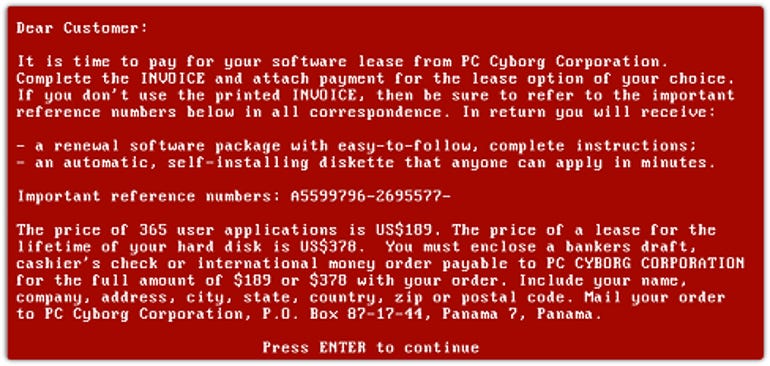
The AIDS demand for payment – by post.
Image: Sophos
How did ransomware evolve?
This early ransomware was a relatively simple construct, using basic cryptography that mostly just changed the names of files, making it relatively easy to overcome.
But it effectively created a new branch of computer crime, which slowly, but surely, grew in reach – and really took off in the internet age. Before they began using advanced cryptography to target corporate networks, hackers were targeting general internet users with basic ransomware.
One of the most successful variants was ‘police ransomware', which tried to extort victims by claiming the PC had been encrypted by law enforcement. It locked the screen with a ransom note warning the user they'd committed illegal online activity, which could get them sent to jail.
However, if the victim paid a fine, the ‘police' would let the infringement slide and restore access to the computer by handing over the decryption key. Of course, this wasn't anything to do with law enforcement – it was criminals exploiting innocent people.
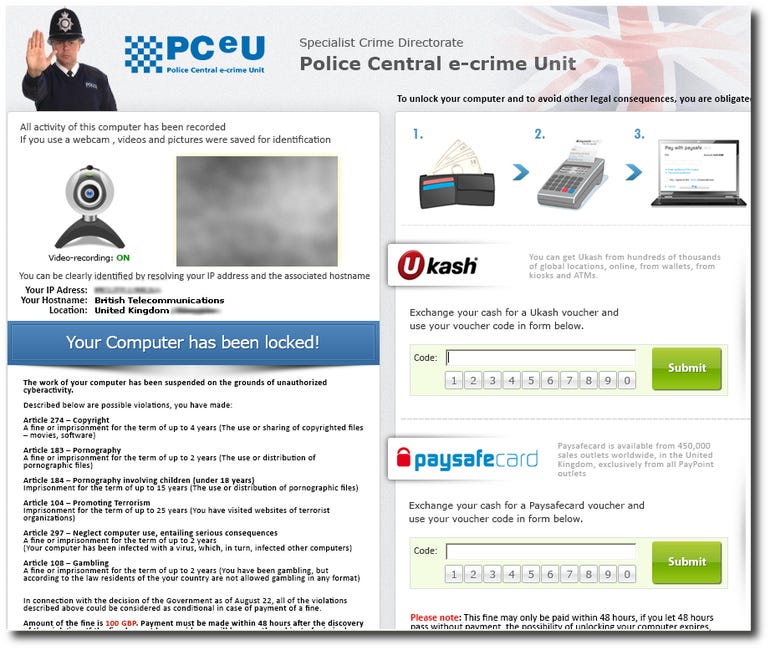
An example of ‘police ransomware' threatening a UK user.
Image: Sophos
While somewhat successful, these forms of ransomware often simply overlaid their ‘warning' message on the user's display – and rebooting the machine could get rid of the problem and restore access to files that were never really encrypted.
Criminals learned from this approach and now the majority of ransomware schemes use advanced cryptography to truly lock down an infected PC and the files on it.
What are the main types of ransomware?
Ransomware is always evolving, with new variants continually appearing and posing new threats to businesses. However, there are certain types of ransomware that have been much more successful than others.
One of the most prolific families of ransomware during 2021 was REvil, which plagued organisations around the world.
Also known as Sodinokibi, this ransomware has been responsible for encrypting the networks of a large number of high-profile organisations, including, Travelex and a New York law firm with celebrity clients.
The gang behind REvil spend a long time laying the groundwork for an attack, stealthily moving across the compromised network to ensure that everything possible can be encrypted before the ransomware attack is launched.
Those behind REvil have been known to demand payments of millions of dollars in exchange for decrypting the data. And given the hackers often gain full control of the network, those organisations that refuse to pay the ransom after falling victim to REvil also find themselves being threatened with so-called double-extortion attacks, with cyber criminals threatening to release stolen information if the ransom isn't paid – a tactic that has been copied by other ransomware gangs. Several suspected members of REvil were arrested in late 2021 and early 2022, leading to a decline in REvil operations.
Another high-profile ransomware group plaguing organisations around the world is Conti, which like REvil, combines encrypting networks with threats to publish data in order to extort ransom payments. The US Cybersecurity and Infrastructure Security Agency (CISA) is among those that have issued warnings about prolific Conti ransomware attacks, which have even claimed healthcare services and hospitals among their victims.
While REvil and Conti have been some of the biggest ransomware threats of 2021 and 2022, new ransomware families are emerging all the time while others suddenly disappear or go out of fashion, with novel variations constantly emerging on underground forums. Any of the top forms of ransomware right now could be yesterday's news in just a few months.
For example, Locky was once the most notorious form of ransomware, creating havoc within organisations around the world throughout 2016, spreading via phishing emails. Locky remained successful because those behind it regularly updated the code to avoid detection and improve functionality.
At one point, Locky became so successful that it rose to become one of the most prevalent forms of malware in its own right. However, under a year later, it appeared to have disappeared and has remained unheard of since.
The following year, it was Cerber that became the most dominant form of ransomware, accounting for 90% of ransomware attacks on Windows in April 2017. One of the reasons Cerber became so popular was the way it was distributed as ‘ransomware-as-a-service', allowing users without technical know-how to conduct attacks in exchange for some of the profits going back to the original authors.
While Cerber seemed to disappear by the end of 2017, it pioneered the ‘ransomware-as-a-service' model that is popular with many forms of ransomware today, allowing cyber criminals to effectively lease out their ransomware, with the would-be criminals giving the developers a cut of the profits.
Throughout 2018 and 2019, another family of ransomware that proved problematic for both businesses and home users was GandCrab, which Europol described as “one of the most aggressive forms of ransomware” at the time.
GandCrab operated ‘as-a-service' and received regular updates, meaning that even when security researchers cracked it and were able to release a decryption key, a new version of the ransomware with a new method of encryption would appear soon after.
Highly successful throughout the first half of 2019 in particular, the creators of GandCrab suddenly announced the operation was shutting down, claiming to have made $2.5 million a week from leasing it out to other cyber-criminal users.
GandCrab disappeared a few weeks later, although it appears as if the attackers could have just switched their focus to another campaign; researchers have suggested strong similarities in the code of GandGrab when compared to REvil.
While ransomware operations come and go, the individuals involved with building and testing the malware regularly move between them or seek new opportunities, meaning there's a steady flow of new ransomware variants to potentially become the next big threat.
What was the Colonial Pipeline ransomware attack?
In May 2021, the Colonial Pipeline, which accounts for 45% of the fuel supply for the US East Coast, temporarily shut down operations because of a ransomware attack.
Fearing supply shortages due to the incident, the US Department of Transport's Federal Motor Carrier Safety Administration (FMCSA) issued an emergency declaration, so road transport of fuel could help meet demands of those not being serviced by the pipeline shut off by ransomware.
Such was the disruption caused by the ransomware attack, with it crippling the IT operations behind the pipeline, that President Joe Biden was briefed about it.
The attack was attributed to Darkside, a ransomware-as-a-service operation. Darkside was a relatively little-known operator in the ransomware space before the Colonial Pipeline incident, but the attack demonstrated that even if the ransomware isn't a high-profile ‘brand' on underground forums, it can still cause massive disruption.
Colonial paid a ransom of millions of dollars to the cyber criminals in order to get the decryption key for restoring the network, although it did little to help. In June 2021, the US Department of Justice announced it had managed to seize most of the bitcoins used to pay the ransom to Darkside in what was the beginning of increased efforts by US authorities to clamp down on ransomware gangs following a series of high-profile incidents.
Darkside itself went dark not long after, but it's likely those involved transferred to other ransomware operations or developed new ransomware under a different name.
What was the Kaseya ransomware attack?
On Friday 2nd July Kaseya, an IT solutions developer for MSPs and enterprise clients announced it had fallen victim to a cyberattack – and it quickly became evident that the attackers has used a flaw to target some of its managed service providers and their customers.
Among the victims were 800 Coop supermarket stores in Sweden, which were unable to open cash registers due to the attack, forcing the stores to close and which temporarily prevented customers from buying everyday items. Kaseya denied that it paid a ransom to cyber criminals.
The incident was attributed to the REvil ransomware gang. In March 2022, a Ukrainian national was extradited to the US for his alleged role in the Kaseya ransomware attack and other REvil campaigns.
What was WannaCry ransomware?
In what's still regarded as one of the biggest ransomware attack to date, WannaCry – also known as WannaCrypt and Wcry – caused chaos across the globe in an attack that started on Friday 12 May 2017.
WannaCry ransomware demanded $300 in bitcoin for unlocking encrypted files – a price that doubled after three days. A ransom note threatened users that all their files would be permanently deleted if the ransom wasn't paid within a week.
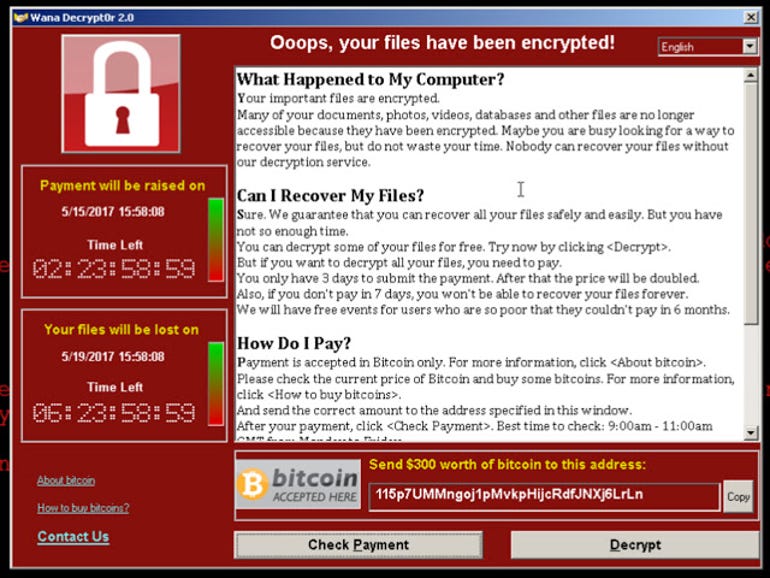
WannaCry ransomware infected Windows XP systems across the globe.
Image: Cisco Talos
More than 300,000 victims in over 150 countries fell victim to the ransomware over the course of one weekend, with businesses, governments, and individuals across the globe all affected.
Healthcare organisations across the UK's National Heath Service (NHS) had systems knocked offline by the ransomware attack, forcing patient appointments to be cancelled and led to hospitals telling people to avoid visiting Accident and Emergency departments unless it was entirely necessary.
Of all the countries affected by the attack, Russia was hit the hardest, according to security researchers, with the WannaCry malware crashing Russian banks, telephone operators, and even IT systems supporting transport infrastructure. China was also hit hard by the attack, with 29,000 organisations in total falling victim to this particularly vicious form of ransomware.
Other high-profile targets included the car manufacturer Renault, which was forced to halt production lines in several locations as the ransomware played havoc with systems.
The ransomware worm was so potent because it exploited a known software vulnerability called EternalBlue. The Windows flaw is one of many zero-days that apparently was known by the NSA – before being leaked by the Shadow Brokers hacking collective. Microsoft released a patch for the vulnerability in early 2017 – but only for the most recent operating systems.
In response to the attack, Microsoft took the unprecedented step of issuing patches for unsupported operating systems to protect against the malware.
Security services in the US and the UK have since pointed to North Korea as being the perpetrator of the WannaCry ransomware attack, with the White House officially declaring Pyongyang as the source of the outbreak.
However, North Korea has labelled accusations that it was behind WannaCry as “absurd”.
No matter who was ultimately behind WannaCry, if the goal of the scheme was to make large amounts of money, it failed – only about $100,000 was paid.
It was almost three months before the WannaCry attackers finally withdrew the funds from the WannaCry bitcoin wallets – they made off with a total of $140,000 thanks to fluctuations in the value of bitcoin.
But despite critical patches being made available to protect systems from WannaCry and other attacks exploiting the SMB vulnerability, a large number of organisations chose not to apply the updates.
It's thought that this lack of patching is the reason LG suffered a WannaCry infection in August – three months after the initial outbreak. The company has since said it has applied the relevant patches.
The public dump of the EternalBlue exploit behind WannaCry has led to various hacking groups attempting to leverage it to boost their own malware. Researchers have even documented how a campaign targeting European hotels by APT28 – a Russian hacking group linked with meddling in the US presidential election – is now using the leaked NSA vulnerability.
What was NotPetya ransomware?
A little over a month after the WannaCry ransomware outbreak, the world was hit with another global ransomware attack.
This cyberattack first hit targets in Ukraine, including its central bank, main international airport, and even the Chernobyl nuclear facility, before quickly spreading around the globe, infecting organisations across Europe, Russia, the US, and Australia.
After some initial confusion as to what this malware was – some said it was Petya, some said it was something else, hence the name NotPetya – researchers at Bitdefender came to the conclusion that the outbreak was down to a modified version of Petya ransomware, combining elements of GoldenEye – a particularly vicious relative of Petya – and WannaCry ransomware into extremely potent malware.
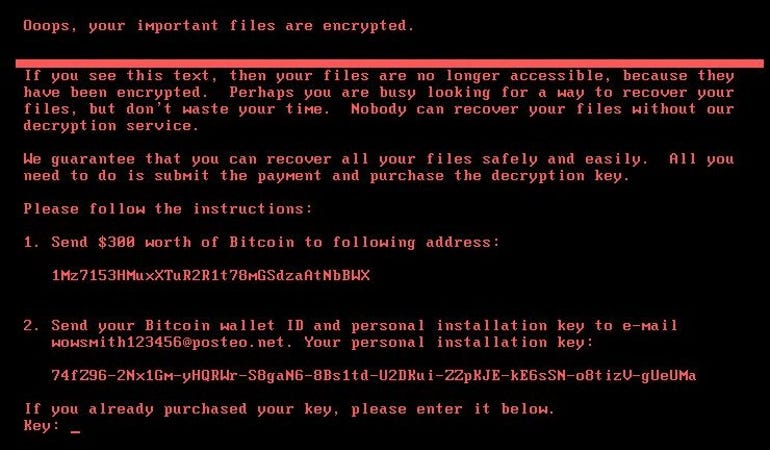
Petya ransom note.
Image: Symantec
NotPetya also exploited the same EternalBlue Windows exploit that powered WannaCry. However, NotPetya was a much more vicious attack. Not only did the attack encrypt victims' files, it also encrypted entire hard drives by overwriting the master reboot record, preventing the computer from loading the operating system or doing anything.
The attackers asked for a bitcoin ransom of $300 to be sent to a specific email address, which was shut down by the email service host. However, the way this very sophisticated ransomware was apparently equipped with very basic, non-automated functions for accepting ransoms has led some to suggest that money wasn't the goal.
This led many to believe the ransomware note was just a cover for the real goal of the virus – to cause mayhem by irrecoverably wiping data from infected machines.
Whatever the aim of the attack, it significantly impacted the finances of the organisations that became infected. UK consumer goods firm Reckitt Benckiser said it lost £100m in revenue as a result of falling victim to Petya.
But that's a relatively modest loss in comparison to other victims of the attack: shipping and supply vessel operator Maersk and goods delivery company FedEx have both estimated losses of $300m due to the impact of Petya.
In February 2018, the governments of the United Kingdom, the United States, Australia and others officially declared that the NotPetya ransomware had been the work of the Russian military. Russia denies any involvement.
How much will a ransomware attack cost you?
Obviously, the most immediate cost associated with becoming infected with ransomware – if it's paid – is the ransom demand, which can depend on the type of ransomware or the size of your organisation.
Ransomware attacks can vary in size but it's becoming increasingly common for hacking gangs to demand millions of dollars to restore access to the network. And the reason hacking gangs are able to demand this much money is, put simply, because plenty of organisations will pay.
That's especially the case if a network being locked with ransomware means the organisation can't do business – it could lose large amounts of revenue for each day, perhaps even every hour, the network is unavailable. It can quickly add up to millions.
If an organisation chooses not to pay the ransom, not only will it lose revenue for a period of time that could last weeks, perhaps months, they'll also have to pay a large sum for a security company to come in and restore access to the network. In some cases, this might even cost more than the ransom demand, but at least the payment is going to a legitimate business rather than funding criminals.
Whichever way the organisation deals with a ransomware attack, it'll also have a financial impact going forward, because to protect against falling victim again, an organisation will need to invest in its security infrastructure, even if that means ripping out the network and starting over again.
On top of all of this, there's also the risk of customers losing trust in the organisation because of poor cybersecurity, which clients taking their business elsewhere.
Paying the ransom is discouraged by cybersecurity and law-enforcement because it encourages cyber criminals to continue to launch ransomware campaigns. There's even instances where a victim has paid a ransom, only for the same attackers to return with another attack and demand another ransom payment.
Why should organisations worry about ransomware?
To put it simply: ransomware could ruin your business. Being locked out of your own files by malware for even just a day will impact your revenue. But given that ransomware takes most victims offline for at least a week, or sometimes months, the losses can be significant. Systems go offline for so long, not just because ransomware locks the system, but because of all the effort required to clean up and restore networks.
And it isn't just the immediate financial hit of ransomware that will damage a business; consumers become wary of giving their data to organisations they believe to be insecure.
Cyber criminals have learned that it isn't just businesses that make lucrative targets for ransomware attacks, with important infrastructure like hospitals and industrial facilities being disrupted by ransomware. Disrupting these networks can have big consequences for people. For example, a ransomware attack against the Irish Healthcare Executive resulted in healthcare appointments being delayed or cancelled for months after the attack.
But ultimataly, the cyber criminals are looking for an easy way to make money and a hospital that finds its network encrypted with ransomware often can't afford to compromise patient care by keeping the network offline for weeks to manually restore it. That's why, unfortunately, many ransomware victims in healthcare will pay the ransom – which was particularly the case during the COVID-19 pandemic.
The education sector has also become a very common target for ransomware campaigns. Schools and universities became reliant on remote learning due to the coronavirus pandemic and cyber criminals noticed. The networks are used by potentially thousands of people, many using their personal devices, and all it might take for a malicious hacker to gain access to the network is a successful phishing email or cracking the password of one account.
The UK's National Cyber Security Centre (NCSC) urged schools and universities to take notice of the growing threat of ransomware, after an incident led to the loss of student coursework, school financial records, as well as data relating to COVID-19 testing.
Why are small businesses targets for ransomware?
Small and medium-sized businesses are a popular target because they tend to have poorer cybersecurity than large organisations. Despite that, many SMEs falsely believe they're too small to be targeted – but even a ‘smaller' ransom of a few hundred dollars is still highly profitable for cyber criminals.
Smaller businesses can also make tempting targets because supply chain attacks can provide access to a larger, more lucrative target.
Why is ransomware so successful?
You could say there's one key reason why ransomware has boomed: because it works. All it takes for ransomware to gain entry to your network is for one user to slip up and launch a malicious email attachment, a weak password being cracked, or businesses leaving vulnerable software unpatched.
If organisations weren't giving in to ransom demands, criminals would stop using ransomware. But businesses need access to data in order to function, so many are willing to pay a ransom and get it over and done with.
Meanwhile, for criminals it's a very easy way to make money. Why spend time and effort developing complex code or generating fake credit cards from stolen bank details if ransomware can result in instant payments of millions of dollars?
Cyber insurance is a policy designed to help protect organisations from the fallout from cyberattacks.
However, some cyber-insurance policies will cover paying the ransom itself – leading some cybersecurity experts to warn that cyber-insurance payouts covering the cost of paying ransoms are adding to the problem, because cyber criminals know that if they hit the right target, they'll get paid.
What does bitcoin and other cryptocurrency have to do with the rise of ransomware?
The rise of crypocurrencies like bitcoin has made it easy for cyber criminals to secretly receive payments extorted with this type of malware, without the risk of the authorities being able to identify the perpetrators.
The secure, untraceable method of making payments – victims are asked to make a payment to a bitcoin address – makes it the perfect currency for criminals who want their financial activities to remain hidden.
Many cyber-criminal ransomware groups offer “customer service” to help victims who don't know how to acquire or send bitcoin to do so, because what's the point of making ransom demands if users don't know how to pay? Some organisations have even hoarded some of the cryptocurrency in case they get infected or their files are encrypted and have to pay bitcoin in a hurry.
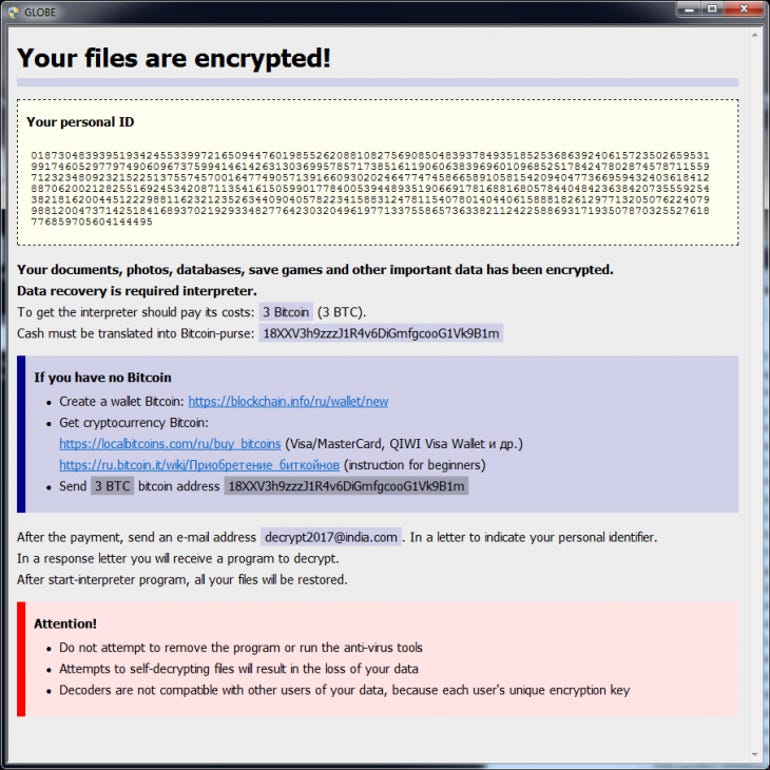
Globe3 ransom demand for 3 bitcoin – including a ‘how to' guide for those who don't know how to buy it.
Image: Emsisoft Lab
How do you prevent a ransomware attack?
With large numbers of ransomware attacks starting with hackers exploiting insecure internet-facing ports and remote desktop protocols, one of the key things an organisation can do to prevent itself falling victim is to ensure that ports aren't exposed to the internet if they don't need to be.
When remote ports are necessary, organisations should make sure that the login credentials have a complex password to protect against criminals looking for a way in. Applying multi-factor authentication to these accounts can also act as a barrier to attacks, as there will be an alert if there's any attempt at unauthorised access.
Organisations should also make sure that the network is patched with the latest security updates, because many forms of ransomware – and other malware – are spread via the use of commonly known vulnerabilities.
When it comes to stopping attacks via email, managers should provide employees with training on how to spot an incoming malware attack. Even picking up on little indicators like poor formatting, or that an email purporting to be from ‘Microsoft Security' is sent from an obscure address that doesn't even contain the word Microsoft within it, might save your network from infection. The same security policies that protect you from malware attacks in general will go some way to stopping chaos across your business.
There's also something to be said for enabling employees to learn from making mistakes while within a safe environment. For example, one firm has developed an interactive video experience that allows its employees to make decisions on a series of events and then find out the consequences of those choices at the end. This process enables them to learn from their mistakes without suffering any of the actual consequences.
On a technical level, stopping employees from being able to enable macros is a big step towards ensuring that they can't unwittingly run a ransomware file.
At the very least, employers should invest in antivirus software and keep it up to date, so that it can warn users about potentially malicious files. Backing up important files and making sure those files can't be compromised during an attack is also key because that makes it possible to recover the network without paying a ransom.
But even if attacks are already inside the network, it isn't too late – if information security teams can spot unusual or suspicious activity before the ransomware attack is launched, it's possible to reduce the scope of the attack or prevent it altogether.
How long does it take to recover from a ransomware attack?
Simply put, ransomware can cripple a whole organisation – an encrypted network is more or less useless and not much can be done until systems are restored.
If your organisation is sensible and has backups in place, systems can be back online in the time it takes the network to be restored to functionality, although depending on the size of the company, that could range from a few hours to days.
One company described to ZDNet in-depth how it took weeks to restore their network to fully operational status, even while restoring the network from backups after refusing to pay the ransom.
However, while it's possible to regain functionality in the short term, it can be the case that organisations struggle to get all systems back up and running for months.
Outside of the immediate impact ransomware can have on a network, it can result in an ongoing financial hit. Any period of time offline is bad for a business as it ultimately means the organisation can't provide the service it sets out to, and can't make money. But the longer the system is offline, the bigger that hit can be.
That's if your customers want to do business with you: in some sectors, the fact you've fallen victim to a cyberattack could potentially drive customers away.
How do I remove ransomware?
The ‘No More Ransom‘ initiative – launched in July 2016 by Europol and the Dutch National Police in collaboration with a number of cybersecurity companies – offers free decryption tools for ransomware variants to help victims retrieve their encrypted data without succumbing to the will of cyber extortionists.
Available in dozens of languages, and now offering 100 ransomware decryption tools, the scheme is regularly adding more tools for new versions of ransomware. It's estimated that No More Ransom has saved victims from paying a combined total of around a billion dollars in ransoms.
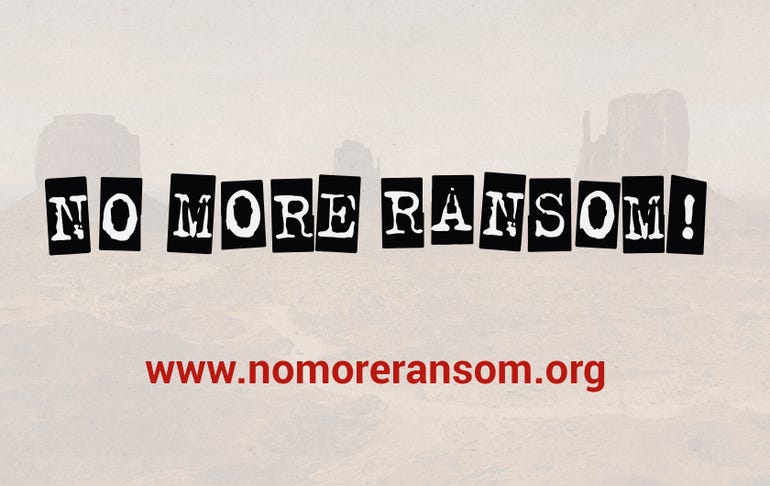
The No More Ransom portal offers free ransomware decryption tools.
Image: Europol
Individual security companies also regularly release decryption tools to counter the ongoing evolution of ransomware – many of these will post updates about these tools on their company blogs as soon as they've cracked the code.
Another way of working around a ransomware infection is to ensure your organisation regularly backs up data offline. It might take some time to transfer the backup files onto a new machine, but if a computer is infected and you have backups, it's possible just to isolate that unit and then get on with your business. Just make sure that crypto-locking crooks aren't able to encrypt your backups, too.
Should I pay a ransomware ransom?
There are those who say victims should just pay the ransom, citing it to be the quickest and easiest way to retrieve their encrypted data – and many organisations do pay, even if law-enforcement agencies warn against it.
But be warned: if word gets out that your organisation is an easy target for cyber criminals because it paid a ransom, you could find yourself the target of other cyber criminals who are looking to take advantage of your weak security. And remember that you're dealing with criminals here and their very nature means they may not keep their word: there's no guarantee you'll ever get the decryption key, even if they have it. Decryption isn't even always possible: there are stories of victims making ransom payments and still not having encrypted files unlocked.
Can you get ransomware on your smartphone?
Absolutely. Ransomware attacks against Android devices have increased massively, as cyber criminals realise that many people aren't aware that smartphones can be attacked and the contents (often more personal than the stuff we keep on PCs) encrypted for ransom by malicious code. Various forms of Android ransomware have, therefore, emerged to plague mobile users.
In fact, any internet-connected device is a potential target for ransomware.
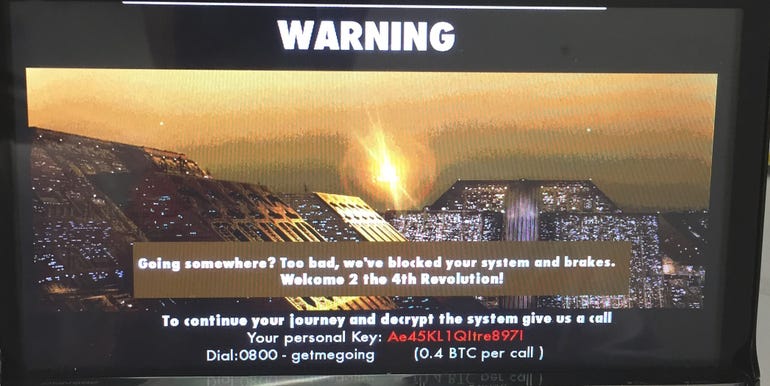
Researchers demonstrate ransomware in an in-car infotainment system.
Image: Intel Security
Ransomware and the Internet of Things
Internet of Things devices already have a poor reputation for security. As more and more of these make their way onto the market, they're going to provide billions of new attack vectors for cyber criminals, potentially allowing hackers to hold your connected home or connected car hostage. An encrypted file is one thing, but what about finding a ransom note displayed on your smart fridge or toaster?
There's even the potential that hackers could infect medical devices, putting lives directly at risk.
In March 2018, researchers at IOActive took this once step further by demonstrating how a commercially available robot could come under a ransomware attack. In addition to making the robot verbally demand payment to be returned to normal, researchers also made it issue threats.
The UK's NCSC has also warned that the growth in smart cities could also be a tempting target for cyber attackers – and it's not hard to imagine that that holding city-wide services to a ransomware attack could be very profitable for criminals.
As ransomware continues to evolve, it's crucial your employees understand the threat it poses, and for organisations to do everything possible to avoid infection, because ransomware can be crippling and decryption is not always an option.

